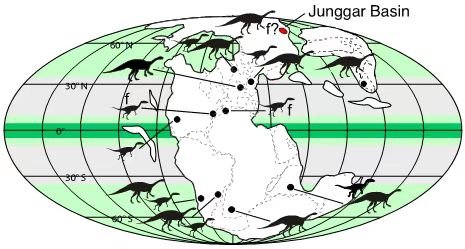The so-called Triassic-Jurassic Extinction(~202millionyearsago) killed off the big reptiles that up until then had ruled the planet, thus clearing the way for dinosaurs to take over. But why did dinosaurs thrive when other creatures died?
Now a new study led by researchers from the Nanjing Institute of Geology and Palaeontology of the Chinese Academy of Sciences (NIGPAS) and Columbia University answers this question.
It reveals that Triassic dinosaur species—then a minor group largely relegated to the higher latitudes—regularly endured freezing conditions, suggesting they were well-adapted to the cold in a way that non dinosaurian species were not. Thus, when the Central Atlantic Magmatic Province (CAMP) caused years to decades of global volcanic winter at the end of the Triassic, dinosaurs were able to survive while then-dominant reptiles could not.
The study was published in Science Advances on July 2.
The researchers’ conclusion relied on two key findings:
First, the researchers found physical evidence of dinosaur footprints from the Junggar Basin in Xinjiang Uygur Autonomous Region of northwestern China. During the Late Triassic to Early Jurassic, this region was located at about 71 degrees north, well above the Arctic Circle. The footprints showed that dinosaurs were present along shorelines.
Second, when the researchers analyzed deep lake deposits, they found abundant pebbles up to about 1.5 centimeters in diameter within normally fine sediments. Far from any apparent shoreline, the pebbles had no business being there. That left only one plausible explanation: They were ice-rafted debris (IRD).
Finding evidence of IRD was crucial to the study because it provided important climate clues.
IRD is created when ice abuts a coastal landmass and incorporates bits of underlying rock as it freezes. At some point the ice becomes unmoored and drifts into the adjoining water body. When it melts, the rocks drop to the bottom, mixing with normally fine sediments. Geologists have extensively studied ancient IRD in the oceans, where it is deposited by glacial icebergs, but rarely in lake beds; the Junggar Basin discovery adds to the scant record.
The researchers said the pebbles were likely picked up during winter, when lake waters froze along pebbly shorelines. When warm weather returned, chunks of ice floated away with pebbles in tow and later dropped them.
“This shows that these areas froze regularly and the dinosaurs did just fine,” said study co-author Dennis Kent, a geologist at Columbia University’s Lamont-Doherty Earth Observatory.
The researchers then used phylogenetic bracket analysis to conclude that the dinosaurs were primitively insulated with feathers. This insulation allowed them to adapt to intense volcanic winters and cold polar conditions so they could take advantage of the Arctic’s deciduous and evergreen vegetation.
“The key to their eventual dominance was very simple. They were fundamentally cold-adapted animals. When it got cold everywhere, they were ready, and other animals weren't,” said Paul Olsen from Columbia University.
While the end of the Triassic is often associated with deadly temperature spikes due to high carbon dioxide concentrations from volcanic eruptions, those same eruptions also deflected a great deal of sunlight, leading to volcanic winters.
“Severe wintery episodes during volcanic eruptions may have brought freezing temperatures to the tropics, which is where many of the extinctions of big, naked, unfeathered vertebrates seem to have occurred,” said SHA Jingeng from NIGPAS. “Where as our fine feathered friends acclimated to colder temperatures in higher latitudes did okay.”
After the biological extinction event at the end of the Triassic, dinosaurs rapidly increased in size and expanded their geographic range, with the total number of dinosaurs nearly doubling. From then on dinosaurs started their135-million-year-long terrestrial domination of Earth.

Fig. 1 The supercontinent of Pangaea 202 million years ago, shortly before the Triassic-Jurassic Extinction. (Image by Olsen et al.)

Fig. 2 A shale cliff in the Junggar Basin in northwestern China, where scientists found ice-rafted pebbles amid otherwise fine-grained sediments. (Image by Paul Olsen)
Story Source:
Materials provided by Columbia Climate School. Original written by Kevin Krajick. Note: Content may be edited for style and length.
Contact:
LIU Yun, Propagandist
Email: yunliu@nigpas.ac.cn
Nanjing Institute of Geology and Palaeontology, Chinese Academy of Sciences
Nanjing, Jiangsu 210008, China
